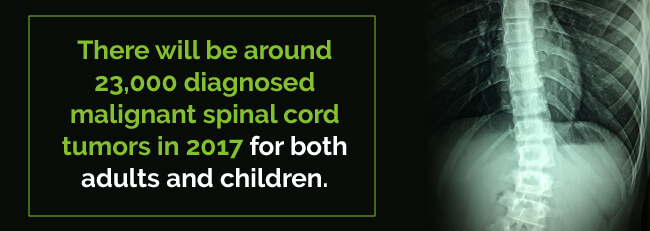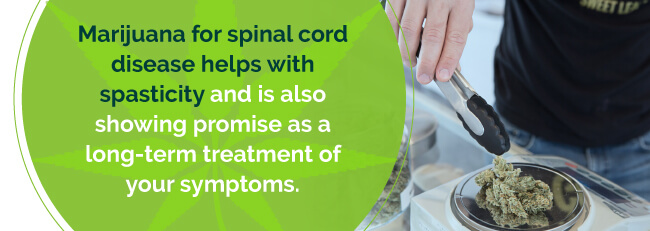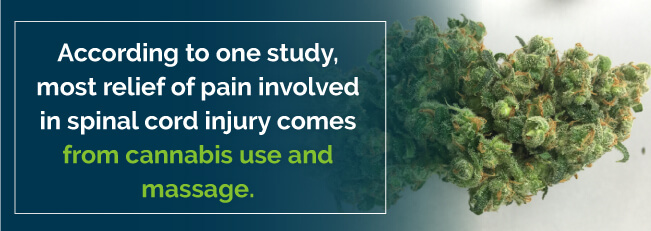
Spinal cord diseases are disorders of the spinal cord that develop for various reasons other than a trauma. Medical cannabis for spinal cord disease can improve pain, spasms, sleep and other complications associated with your spinal cord disease.
Your spinal cord is an important part of your nervous system. It transmits messages between your body and brain. Spinal cord problems can cause a loss of movement and sensation.
Often, acute trauma, like a car accident, that causes spinal cord injury (SCI). However, certain conditions and illnesses are the trigger for spinal cord disease.
Several conditions may affect your spinal cord and keep it from working properly, including:
Tumors of the spine also impact the function of your spinal cord. According to the American Cancer Society, there will be around 23,000 diagnosed malignant spinal cord tumors in 2017 for both adults and children.

Examples of disorders and diseases that are associated with spinal cord disease include:
In many cases, physicians recognize a disorder of your spinal cord based on your symptoms and characteristic patterns. To determine the extent of your spinal cord damage and confirm a diagnosis, your doctor will perform a physical exam. In addition to a physical exam and discussion of your symptoms, your doctor may take an imaging test to determine the cause and confirm your diagnosis.
Throughout most of medical and scientific history, doctors considered paralysis and spinal cord disease untreatable and irreversible. In fact, even in ancient Egypt, doctors believed nothing could treat an individual with spinal damage. And, despite our comprehension of the nervous system and how it functions has strengthened over time, the belief persists that central nervous system nerves of the spinal cord can’t regrow after being injured.
However, this theory has finally been put to rest over the past 35 years or so. Doctors have known for a while that damaged peripheral nerves in the body can regenerate and full function can be restored. As a result, scientists wondered what was so special in the peripheral nerve environment to be able to achieve this amazing feat.
Rat experimentation in the 1980s revealed the cells in the central nervous system (CNS) could regrow their axons or nerve fibers under a lab environment that copied the peripheral nervous system.
Researchers began identifying the precise molecular conditions that stimulate axons to regenerate in the human body. They identified the factors that keep axons in the central nervous system from regrowing. The first identified obstacles were in the late 1980s. These were active regeneration-block proteins made by the myelin sheath which wrap the nerves around the CNS. Axons could thrive by getting rid of the blocking proteins.
This finding brought new hope into the field that was once deemed hopeless. It also guided in a new research era involving the complete scope of spinal cord biology.
Because of the way your spinal cord is organized and how it functions, cord damage usually produces particular symptom patterns based on the location of the damage. The following symptoms that may occur in a variety of patterns include:
You may lose functions partially or entirely. Functions above the damaged area of the spinal cord aren’t affected. When you have sudden weakness or paralysis, your muscles go limp and lose their tone. Once they become flaccid, your muscles begin to contract involuntarily, which is known as spasticity, or spasms.
The changes you experience in how your body functions may get overwhelming at first, but rehabilitation can help you develop methods required to address these changes. Areas that are typically affected include:
Even though your intestines and stomach continue to work like they always have before your spinal cord disease, you’ll often struggle with controlling your bowel movements. Adding high-fiber content to your diet can help regulate your bowels.
Your bladder keeps storing urine from your kidneys, but since your spinal cord that carries the urination message has been injured, your brain may not be able to control your bladder. Because of this, your risk of urinary tract infections increases. You may also be susceptible to kidney or bladder stones or kidney infections.
Your spinal cord disease can cause circulatory issues that range from swelling of your extremities to low blood pressure upon standing up. These changes in circulation can increase your risk of pulmonary embolus, deep vein thrombosis and other types of blood clots.
Another circulatory control problem is autonomic hyperreflexia, which is a potentially life-threatening rise in blood pressure.
You may lose part or all skin sensations below your injury’s neurological level. Because of this, your skin can’t send your brain a message when certain things like heat, cold or continued pressure injure it.
You will also become more vulnerable to pressure sores — however, remembering to change positions frequently should help prevent these sores.
You may experience a couple of types of muscle tone problems. These include uncontrolled muscle spasms or twitching, as well as limp or soft muscles that lack tone.
Spinal cord disease can make it harder for you to cough and breathe if your chest and abdominal muscles are affected. These muscles include those in your abdomen, chest wall and diaphragm.
The type of breathing problems you have depends on the neurological level of your injury. If you have thoracic and cervical spinal cord injury, this could increase your risk of lung problems, such as pneumonia.
Muscle atrophy and weight loss are common with spinal cord disease. You may have limited mobility that can cause you to live a more sedentary lifestyle. This places you at risk for developing cardiovascular disease, obesity and diabetes.
You can work with a dietitian to sustain a healthy weight by eating a nutritious diet. An occupational and physical therapist can help you set up an exercise and fitness regimen.
Spinal cord disease could affect your sexual function, sexuality and fertility. Women may experience changes in lubrication. Men may experience changes in their erections and ejaculation. A fertility specialist and urologist who specialize in spinal cord disease may be able to offer you options for fertility and sexual functioning.
You may experience pain, including joint and muscle pain, from overusing certain muscle groups. After being afflicted with spinal cord disease, you may also experience nerve pain, also known as central or neuropathic pain.
Having to cope with all the changes brought on by spinal cord disease and the associated pain causes some people to struggle with depression. Medications and therapies can help you fight the depression brought on by your spinal cord disease or injuries.
When you lose your body functions extensively, it can be devastating. Not only can it cause you to lose your self-esteem, but you also might slip into a depression. You may find help with formal counseling that can help you learn what’s happened, what you can expect in the future to cope with this loss and prepare you for rehabilitation.

Treatment with medications differs among individuals because the causes of degenerative spinal cord disease vary. Some medications and side effects may include:
Talk with your doctor about the proper medications for your particular case of spinal cord disease.
Rehabilitation can help you get back as much function as you can. You’ll receive the best care through a rehabilitation team that includes a physical therapist, nurses, doctors, occupational therapist, psychologist, social worker, counselor and a nutritionist. Of course, you should involve your family and friends too.
A nurse can teach you ways to manage your bowel and bladder dysfunction, such as when to use laxatives, how to insert a catheter, or how to use your finger to stimulate bowel movements.
Occupational therapy can help you relearn daily activities and tasks and improve your coordination and dexterity. You’ll learn unique methods that help you compensate for lost functions. Counselors and therapists help you make necessary adjustments you’ll need to return to work, hobbies and other activities. Therapists can teach you how to deal with sexual dysfunction, and although you’ll likely lose some or all sensation, you can still have sex.
Physical therapy involves exercises for muscle stretching and strengthening. You’ll learn how to use a walker, braces, wheelchair and other assistive devices, and how to manage your muscle spasms.
With spinal cord disease, you may also experience spasticity. It’s also another area of medical cannabis research. Similar to multiple sclerosis, SCI causes pain medical cannabis can treat. Marijuana for spinal cord disease helps with spasticity and is also showing promise as a long-term treatment of your symptoms that’s a safer alternative to traditional pain relievers and sedatives.

Minor side effects of cannabis and spinal cord disease treatment may include:
Spinal cord disease can have permanent and debilitating effects on your well-being and daily life. But research is barely touching the surface of developing effective medications for the disease without side effects and the potential for addiction.
Studies documented medical cannabis for spinal cord disease and its ability to fight spasticity and pain in patients with the disorder as early as the 1970s. Today, cannabis offers you an alternative regimen for treating the unpleasant and relentless symptoms associated with this spinal disorder that can take a huge toll on the quality of your life.
When you use cannabinoids soon after diagnosis of spinal cord disease, they can limit the damage by stimulating a neuroprotective response. This early internal CB1 and CB2 receptor activation shortly after diagnosis of the spinal disorder provides a protective response that contributes to spontaneous recovery.

According to one study, most relief of pain involved in spinal cord injury comes from cannabis use and massage. These combined therapies help alleviate the chronic pain and other symptoms associated with SCI.
Symptoms relieved by cannabis for spinal cord disease include:
These are only a handful of the symptoms SCI patients struggle with on a daily basis and that medical marijuana can help treat.
THC (delta9-tetrahydrocannabinol) and CBD (cannabidiol) were found to provide more significant pain relief when compared to a placebo in a study involving 18 SCI patients. Marijuana and spinal cord disease treatment also improved muscle spasms, spasticity and impaired bladder control.
Although self-medicating with weed seems like an easy decision, the thousands of strains available may confuse and overwhelm you, making it difficult to decide which one is the right strain for your symptoms.
There are two main species of marijuana: Indica and Sativa. Indicas have more CBD and CBN (cannabinol) than they do THC. Sativas have more THC than they do CBD and CBN.
Hybrid strains contain both Indica and Sativa. CBN, CBD and THC are all cannabinoids, which are beneficial compounds in cannabis. They provide you with varying levels of psychoactive and medical effects.
Some strains you’ll find beneficial for relieving your symptoms of spinal cord disease include:
Keep in mind there are other strains that may work well for you, and working with a budtender for your medical marijuana needs can help you find the ideal strain or combination of strains.
To obtain your medical marijuana and spinal cord disease strain, search for a medical marijuana dispensary or doctor for help and to improve the quality of your life.
Find A Doctor Find A Dispensary